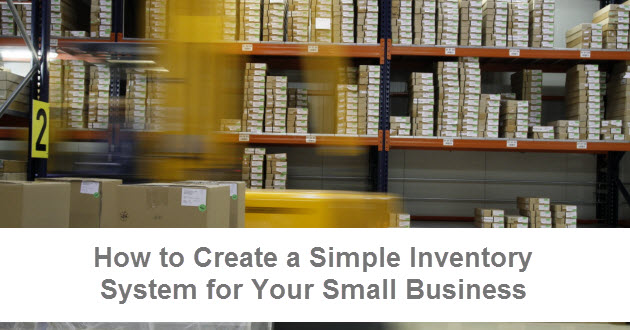How to Create a Simple Inventory System for Small Business
Inventory management is imperative for running a small business.
You must make sure you have the right products and the proper quantities to sell customers when they need it, and you must organize this data to prevent overstock, loss of revenue, and unsold products.
In the modern age, the best method of organizing inventory is to use a software program, and in this article we'll discuss inventory management and provide actionable tips to teach you how to create a simple inventory system for small business.
Related: 8 Best G Suite Inventory Management Software Options for Businesses
What is Inventory Management?
Inventory management is a major step in the retail supply chain. This chain is the system that moves the product from creation, to supplier to consumer.
There are four main parts of a retail supply chain which include:
- Product manufacturers who create the product,
- Wholesalers that buy products in bulk to distribute the product,
- Retailers who purchase the product from wholesalers and sell the product to consumers,
- Customers who purchase the product.
Although there are different variations of the retail supply chain such as direct to consumer products, or wholesalers shipping to consumers, online businesses usually act as a middle man in some way.
Why Inventory Management is Important

The point of inventory management is to keep inventory levels balanced, an at the ideal level to make the most profit.
You never want to have too much or too little of your product in stock, or not be aware of what stock you have coming. Keeping track of purchase orders from or to suppliers is also incredibly important. Especially if you vend perishable or expirable goods, monitoring stock levels continually is vital for the success and profit of your business.
Retail inventory management connects financials such as sales and costs of goods sold, to actual products. This way retailers can make up for losses of slow-selling periods or theft.
In short, inventory management increases profits and saves time.
Organize Product and Vendor Information
First it is important to set up your stock and supplier information in a good system. You can choose to use a manual method such as a spreadsheet, but a POS (point of sale) system seems to be the better and more modern option.
However you decide to organize your information, you will need to include both product and supplier details. This includes:
- The product name,
- SKU number or code if needed,
- UPC/EAN or other identifier,
- A description of the product,
- The product category, family or class,
- Wholesale cost,
- MSRP/retail price
- Your sale price
- Colors or other options such as sizes available,
- Vendor or manufacturer name,
- Quantities needed to reorder
- Shipping details such as the weight, size, and how it is packaged
- Image of the product
By managing and recording your products properly, you will be able to easily search and know exactly what has been sold, and exactly what needs to be reordered.
Additionally, vendor and supplier information should be added as well. The information you will need to record regarding your suppliers include:
- Name of vendor
- Contact name of vendor
- Billing information
- Phone number
- Payment terms
- Contact to the showroom if applicable
Manage How You Receive Your Inventory

Having a well running inventory system requires a lot of organization. This means that you will need to manage how you receive and input new stock from suppliers, into your POS system.
You want everything you input to be as accurate as possible. The best way to go about this is to have a process that you follow each time, in exactly the same manner. Oftentimes the owner of a small business might choose to do this themselves, or you can choose one trusted employee to do so.
Use Proper Tools

Although it is possible to use spreadsheets or even the old fashioned way of writing with a pencil and paper, the best way to manage an inventory system is with a POS system that you trust or a custom, cloud-based system like the one we've created for a number of our clients.
This is due to the fact that human error does occur, and the rate of data that you will receive in most small businesses is a lot to handle without the use of a proper technology system.
If you do not use a POS system, you might also feel overwhelmed with the task, and abandon it all together, which would be detrimental to your business.
Generally, by using a digital tool, most of the process will be automatic. When you sell a product, your stock levels update, and you can be aware when you are about to sell out, or if you need to reorder.
Make Decisions Based on Real Data
The reports you will receive by using a POS will greatly help to improve your business. Not only will you be able to view sales volume by product, but also inventory turn over and profit margin analysis.
This way you can make informed decisions that you might otherwise overlook.
Create a Standardized Process
Although a POS system or inventory management software can truly help you to get value from your data, there should still be an overarching process that you have in place.
There are two methods of this which are popular with small business users. The first is FIFO (First In, First Out), and LIFO (Last In, First Out).
FIFO is the method of attempting to sell older stock before newer stock. This is important for businesses that sell perishable or expiring goods.
On the opposite end of the spectrum, LIFO prioritizes selling newer items first. The reason for using the LIFO method is when prices of stock fluctuates often. If the cost of the product increases, this will cause the company’s margin to decrease. This results in lower revenue and less taxes to be paid. This is the main reason that a small business might choose LIFO over FIFO.
Whichever method you choose, make sure to fully investigate to decide which method will work best for you and your small business.
Recommended: How to Reduce Operating Expenses in Business
Be Consistent with Inventory Counts

Regardless if you have a POS system or inventory management tool, make sure you do manual inventory counts as well.
This is important to do monthly, quarterly or semi-annually depending on the size of your business. This is important in case of theft, or flaws in your process.
Knowing When to Reorder

This is one of the more difficult parts of managing your inventory, but there are ways to set up reorder triggers within your POS system. This means you can set an alert to notify you when a certain product is at a specific low stock level.
Track Raw Goods
Although many systems focus on retail businesses that contain goods or clothes, there are plenty of businesses using inventory management for food service.

One specific piece of information for food service businesses is to monitor ingredients and the quantities you need of them, at what time.
For example, a bakery might need eggs, flour, milk and chocolate, but in different amounts all at different times.
Figure this out and have it programmed into your inventory management system to avoid over, or under, ordering.
Inventory Shrinkage
This is a huge threat to your profit margins and includes theft by employees or shoplifters, and supplier error or damages.
Retail shrinkage actually caused $46.8 billion in loss of money for U.S retailers in 2017.
To attempt to avoid these issues, the best way is by keeping intense inventory counts, and monitoring yourself, with a security staff, or by a trusted manager.
Creating a Simple Inventory System for Small Business with Google Cloud Platform

Now that you have a set of tools and principles to make an inventory for your small business, start slowly and test a few ideas out.
As a certified Google Cloud Premier Partner specializing in small business, Suitebriar would be happy to speak with you about your unique needs and to give you a quote to design a custom inventory management solution that will help your business grow.







